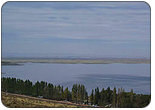 Our goal is to restore recreational fishing on Potholes Reservoir to the level once enjoyed. Today we have excellent Bass and Walleye fishing. A recent WDFW study on Potholes Reservoir has determined a dangerous predator advantage. Without the habitat to provide a foothold for the forage base of Perch, Crappie, and Bluegill to propagate, ultimately this reservoir fishery will crash, and the recreational fishery will be dominated by stunted walleye. Potholes Reservoir, according to WDFW biologists, supports 22 species of fish; however, many of these species are suffering low populations caused by predation and lack of habitat during periods of low water, due to irrigation demands. Potholes Reservoir has suffered a decline in the Perch, Crappie, and Bluegill fishery. This decline has resulted in fewer visitors to the area. With improved fishing opportunities, the Central Basin will experience a positive economic impact through increased fishing license sales, food, fuel, tackle sales, and overnight stays (motels and lodges). What is good for the fish will also be good for the outdoor enthusiasts in our state. Habitat is the primary key to success. The goals of this habitat committee are to revitalize the waning populations of fish through habitat, help stimulate area economic growth, and to ultimately re-establish a fishing and recreational destination to be enjoyed by all.
Our goal is to restore recreational fishing on Potholes Reservoir to the level once enjoyed. Today we have excellent Bass and Walleye fishing. A recent WDFW study on Potholes Reservoir has determined a dangerous predator advantage. Without the habitat to provide a foothold for the forage base of Perch, Crappie, and Bluegill to propagate, ultimately this reservoir fishery will crash, and the recreational fishery will be dominated by stunted walleye. Potholes Reservoir, according to WDFW biologists, supports 22 species of fish; however, many of these species are suffering low populations caused by predation and lack of habitat during periods of low water, due to irrigation demands. Potholes Reservoir has suffered a decline in the Perch, Crappie, and Bluegill fishery. This decline has resulted in fewer visitors to the area. With improved fishing opportunities, the Central Basin will experience a positive economic impact through increased fishing license sales, food, fuel, tackle sales, and overnight stays (motels and lodges). What is good for the fish will also be good for the outdoor enthusiasts in our state. Habitat is the primary key to success. The goals of this habitat committee are to revitalize the waning populations of fish through habitat, help stimulate area economic growth, and to ultimately re-establish a fishing and recreational destination to be enjoyed by all. Columbia Basin
Columbia Basin
Potholes Reservoir is part of the Columbia Basin Irrigation Project. It is formed by the O'Sullivan Dam and located in central Washington, in the United States. The reservoir is fed by water from Moses Lake, part of the Crab Creek basin.

Potholes Reservoir is a multi-species warm water lake in Central Washington, 16 miles SW of Moses Lake. This arid desert land, which was flooded on August 15, 1949, provided fantastic perch, crappie, bluegill and bass fishing in the early years. Eventually the flooded natural shrubs and sage brush began to deteriorate. In 1980 the eruption of Mount St. Helens added 4 inches of volcanic ash to the bottom of Potholes Reservoir. The lake bottom now resembles a moonscape without sanctuary for young fish from their natural predators. The sand dunes, located at the north end of Potholes Reservoir, provided habitat in the spring but as the summer progresses the lake drops and the fish migrate into the main body, the moonscape. The habitat boxes will provide a place for small fish to live and grow, safe from predators.

Species Composition
This graphic represents the current percentage of fish species located in the Potholes Reservoir.
If you desire a DVD Presentation for your company or organization we can provide one at no charge. Please contact us by clicking here.













